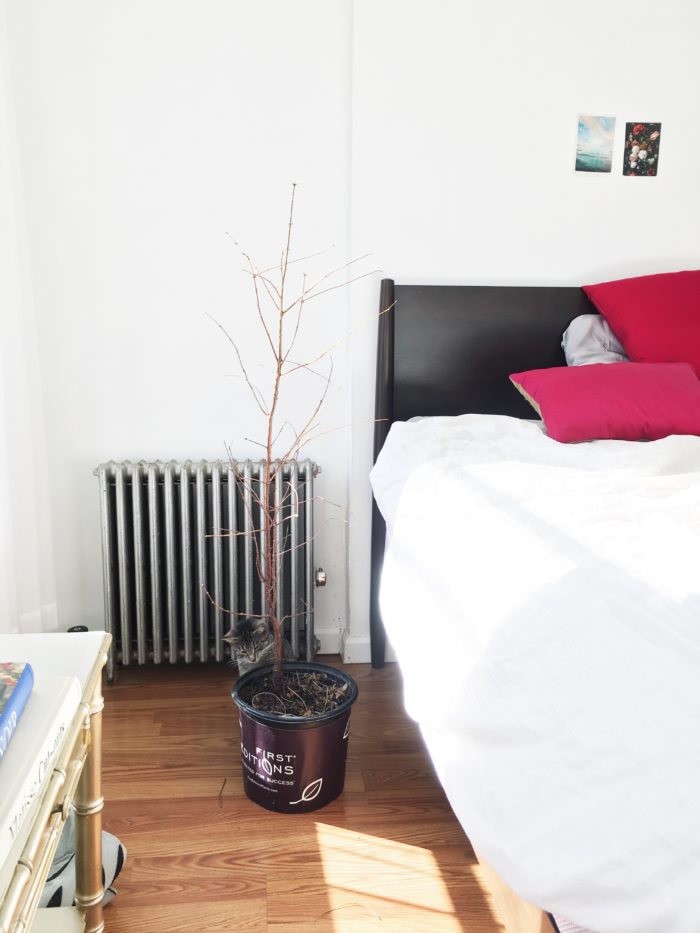When I graduated from college and moved to NYC, the very first pieces of furniture I bought were a wooden desk from Target.com, and some sort of painted wooden dresser and a metal bed frame/mattress from Ikea. At the time, I didn’t stop to think what made it possible for a recent college grad to buy brand new furniture for $100-150 a piece. I was just glad not to have to sleep on the floor! But in less than a year, all those pieces began falling apart. (The drawers in my dresser were never even parallel to begin with–and whose fault is it, mine or Ikea’s?!). I threw them out when I left my Brooklyn loft for an apartment in Harlem, feeling super guilty about creating so much waste.
Now I know that not only did I create massive landfill waste for just a few years’ “convenience,” I was also unwittingly a part of a global scheme that destroys ancient forests, deprives the world of its most vital carbon sinks, and kills wildlife, including the very same species to which I feel such a strong spiritual connection: the Amur tiger (aka Siberian tiger) and the Amur leopard.

We think that because we buy these furnishings from a brightly lit showroom in a developed world, that their origins are just as sanitized and *wholesome*. But first-world furniture comes through incredibly dark and unregulated origins. According to the WWF, around 30% of Russia’s logging exports are illegally harvested. In his acclaimed book, The Tiger: A True Story of Vengeance and Survival, John Vaillant goes deep into the Russian Far East and describes the “Wild Wild East” where the trucks controlled by the mafia go into the forest at nightfall to cut down invaluable Korean pines, destined to cross the Chinese border. The local authorities are usually bought out, but anyone challenging the mafia will mysteriously “disappear” in the woods.
Once over the border, the timber is turned into anything from a hardwood toilet seat to hardwood floor to $100 desk and $80 dresser. This leads to the destruction of not just the trees, but whole ecosystems, including two of the most endangered large mammals in the world. There are only about 500 Amur tigers remaining in the wild, while the number for the Amur leopard is just 30-80, according to different estimates.
 A mother and a cub at the Buffalo Zoo
A mother and a cub at the Buffalo Zoo
It’s not just big-box stores like Walmart and Target who are buying furniture from unidentified sources. High-end retailer Lombok (UK), which sells “handcrafted Eastern/Colonial-inspired dark teak furniture,” recently was prosecuted for sourcing from unknown Indian logging sites. And don’t go believing Ikea’s sustainable Swedish image: in 2012, Swedish public service TV reported that Swedwood, the wholly owned subsidiary of Ikea, cuts down 1,400 acres of forest a year in the old-growth forests of Russian Karelia. Swedwood clear-cut areas containing 200-600-year-old trees in Karelia (near Finnish border, so not the Far East). At the time of the report, only about 10% of the ancient forests remained in Karelia. This is made even more horrendous given that Swedwood is a Forest Stewardship Council-registered company, and Ikea has long used the “We Love Wood” slogan to promote itself as an environmentally sustainable company.
Ikea continues to issue rose-tinted (green-tinted?) proclamations. In 2017, its sustainability report claimed that 77% of its wood products come from FSC-certified or recycled sources. That’s all so tempting to believe at face value. We want nice, clean, minimalist-chic furniture that is easily transportable and unbelievably cheap! But if that sounds too good to be true, it probably is.
A wild tiger at the Bastak Nature Reserve, Russian Far East
But wait, there’s more! The tragedy of this extends beyond the boreal forests of Northern hemisphere. The demand for African rosewood has led to yet another chain of illegal/sub-legal trafficking and deforestation in Madagascar. The Guardian reports that “China’s craze for rosewood has driven dramatic increases in illegal logging elsewhere in the world.” At this rate, “we risk not having [the African rosewood] in the coming years.”
So what can *you* do about this crisis?
- Avoid buying new furniture as much as possible: The best way to combat logging and deforestation is to reduce demand for raw materials.
- Buy vintage: Honestly, vintage is aesthetically so much more pleasing, too. There are a wealth of treasures at places like Housing Works (secondhand shops in NYC), local estate sales, etc. My parents have a ton of gems they picked up over the years. I also picked up a pair of nightstands from neighbors in my apartment building. Reuse and reduce!
 These gorgeous chairs were picked up at garage sales around Portland, Oregon for $5.
These gorgeous chairs were picked up at garage sales around Portland, Oregon for $5. I got this gorgeous vintage wooden chest from Housing Works for about $300. Worth every penny, adds so much character!
I got this gorgeous vintage wooden chest from Housing Works for about $300. Worth every penny, adds so much character! - When you have to buy new furniture, look into the sources: Sometimes you just absolutely need to buy a new piece. In that case, make it a priority to look for the FSC label and other certifications. Yes, we just talked about how those labels might not mean much. But if *they* don’t guarantee truly sustainable forest management, then what does that mean for all the unlabeled furniture? Think of this as the last line of defense.
 This West Elm bed in my apartment is fair-trade and FSC-certified. The nightstand (on the left bottom corner of the frame) is one of a pair discarded by my neighbors. I painted it with non-toxic bronze paint! Look at the non-toxic kitty also!
This West Elm bed in my apartment is fair-trade and FSC-certified. The nightstand (on the left bottom corner of the frame) is one of a pair discarded by my neighbors. I painted it with non-toxic bronze paint! Look at the non-toxic kitty also! - Reduce other sources of wood and paper waste: There’s not really a reason we should be printing a lot of things nowadays, but find other ways to avoid paper! Buy recycled paper towels and toilet paper. To be honest, I don’t know why paper napkins are such a thing–if you eat carefully, you don’t need to use them really, at least at home. When I have company, I set out cloth napkins for my guests. Classy *and* wood-saving!
 Vegan Thanksgiving table set with linen napkins
Vegan Thanksgiving table set with linen napkins - Support the woods: You can help WWF protect the habitats of both the Amur tiger and the Amur leopard. A large part of their work is about preventing illegal logging and working with local communities to ensure the preservation of the forests.

Do you have any lovely vintage furniture?
Related: 4 Pieces Of Eco-Chic Reclaimed Wood Furniture To Make You Win At Instagram
Feeling Stuck Where Your Live? 5 Ways To Make Your Space Feel New & Exciting
Worried About Pet Health? How To Give Your Fur Baby A Green Lifestyle To Match Your Own
Get more like this–sign up for our newsletter for exclusive inspirational content!
__
Photo: Peaceful Dumpling, Wikipedia commons (both tiger pics), Alexander Hörl on Unsplash

